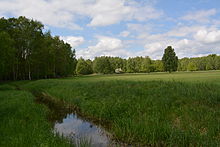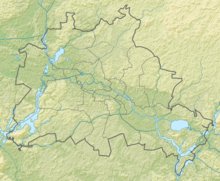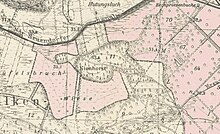Ice Cellar (Berlin)
Coordinates: 52 ° 35 ′ 0 ″ N , 13 ° 8 ′ 0 ″ E

The Eiskeller is an area consisting of a few houses, meadows and a farm at the north-western end of Berlin in the Hakenfelde district .
The area was given the name Eiskeller because of its significantly lower temperatures in the winter months than in the rest of Berlin. Temperature differences between the center of Berlin and the Eiskeller area of ten degrees Celsius can be achieved. The exact origin of the name is unclear, however, as the name has probably only been used since the 1960s. Earlier names of the area were Kienhorst and Teufelsbruchwiese .
Eiskeller is considered the coldest place in Berlin in winter. For this reason, ice was previously stored there, which was made from the nearby Falkenhagener See and then sold to breweries and hospitals after being temporarily stored in an ice cellar.
In summer, however, the steppe-like area can get hotter than the surrounding area.
The Eiskeller landscape protection area with an area of 51.6 hectares and a meadow under special protection as an extensive natural monument were merged into the Eiskeller and Spandauer Luchwald nature reserve in December 2017 .
history
Since the formation of Greater Berlin in 1920, Eiskeller was initially almost an exclave of Berlin in the surrounding area, later of West Berlin in the GDR . The connection from Eiskeller, where around 20 people lived on three farms when the Wall was built , with the rest of Berlin was a four meter wide and 800 meter long corridor. Within the area there were again enclaves of various Brandenburg communities and thus the GDR.
South of Eiskeller - surrounded by GDR territory - was the West Berlin exclave Große Kuhlake . In an area swap in 1972, access to Eiskeller was widened, the GDR enclaves in Eiskeller came to West Berlin and the Große Kuhlake and a small area on the western edge of Eiskeller in return for the GDR. In a further exchange of territory between the GDR and West Berlin, 14 GDR areas were added to West Berlin in 1988 and four West Berlin exclaves to the GDR. As part of this exchange, the border in the Eiskeller area was rounded off in favor of Berlin , and the Grosse Kienhorst forest area in the south-east of Eiskeller became part of West Berlin.
After 2000, three families lived in Eiskeller.
Others
In 1961, a boy claimed that he had been stopped by police officers on the way from Eiskeller to school in Berlin-Spandau . The British took the child to school in an armored car. It wasn't until 33 years later that he confessed that he'd just made up the story to skip school.
Web links
- Map of the exchange of territory in 1988 ( Memento from January 26, 2017 in the Internet Archive ) (PDF; 3.8 MB)
- Berlin Enclaves ( English )
- Protected Area Ordinance
Individual evidence
- ↑ a b T. Wiehle: Hike in the ice cellar. In: berlin.de. September 2008, accessed January 17, 2018 .
- ↑ Norbert Heintze: Ice cellar and ice works in Berlin and Brandenburg . 3. Edition. Berlin 2014, p. 217 ( zlb.de [PDF; 14.2 MB ; retrieved on January 19, 2018] In the holdings of the Central and State Library Berlin).
- ↑ Claudia Fuchs: In Eiskeller, winter is always a bit frostier than in the rest of the city: Berlin's North Pole. In: berliner-zeitung.de . December 22, 2001. Retrieved January 19, 2018 .
- ↑ a b Heat island, cold hole: A visit to the ice cellar . In: Der Tagesspiegel , March 4, 2003, accessed on November 9, 2016.
- ↑ a b Christian Simon: Berlin Grotesk. The wall in the absurd everyday life of a megacity. Christian Simon Verlag, Berlin 2011, ISBN 978-3-936242-14-0 , pp. 62-64.
- ↑ truancy confesses his prank after 33 years . In: Berliner Zeitung , May 9, 1994, accessed on July 14, 2013.





